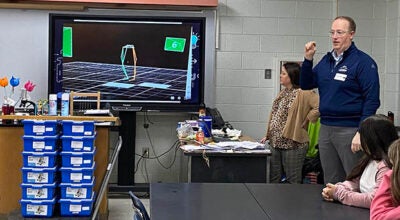Solar Farms in Virginia
Published 3:58 pm Saturday, July 30, 2022
|
Getting your Trinity Audio player ready...
|
By Faith Redd
The Charlotte Gazette
The rise in the use of solar energy technology to generate electricity is a booming industry in Virginia with 52 active solar facilities that generate more than 5 megawatts of power.
These Virginia Department of Energy numbers, combined with the many requests by companies seeking to locate additional solar farms across the region, have those who support the alternative source of power celebrating and those with questions about the facilities raising concerns about the budding industry.
Virginia’s solar farms now generate about 2,667 megawatts, which is enough to power more than 530,000 homes, according to the Virginia Department of Energy.
“This is a really exciting topic in Virginia,” said Dominion Energy representative Aaron Ruby. “We are transforming Virginia to be zero carbon in the next 20-25 years.”
Solar technology converts sunlight into electrical energy through photovoltaic panels, or mirrors that concentrate solar radiation, according to the Office of Energy Efficiency and Renewable Energy. This energy generates electricity for homes and businesses and can be stored. The energy produced feeds into the power grid to reach customers through their local utilities.
The proponents of solar power point out that the amount of sunlight that hits the earth’s surface in just 90 minutes is enough to fulfill the world’s energy consumption for a year.
The pros of solar
Along with generating clean energy for homes and businesses across Virginia, solar farms also provide many other benefits, such as economic development in neighboring communities.
Apex Clean Energy of Charlottesville is developing the Riverstone Solar project in Buckingham County. It is expected to generate energy for 29,000 homes per year with its 150 megawatt output, according to Riverstone Solar.
Riverstone Solar also will bring full- and part-time jobs to the community during construction and operations phases and taxpayers are protected against decommissioning costs, according to the company’s website. Its low panel height limits the facility’s visibility on nearby roads and neighboring communities, according to the company.
Dominion Energy is now working on a solar sighting agreement with Buckingham County to provide additional funding for critical community needs, according to Ruby. The project will generate construction jobs, and increase spending at local vendors and contractors.
David Murray, director of Solar Policy at American Clean Power Association, believes that solar farms increase local revenue.
“I think that’s why you’ve seen a number of these projects move forward in Virginia because it’s a great economic proposition for these counties,” said Murray.
The American Clean Power Association met to find policies that would ensure that local governments will see more tax benefit from solar facilities in 2019, according to Murray. This led to a policy called the revenue share.
Revenue share allows facilities to earn $1,400 a year for every megawatt of solar that was in a locality. A facility generating 5 MW would produce $7,000 in revenue that goes to the town, city or county.
The cons of solar
Solar farm workers are exposed to a variety of serious hazards, according to federal Occupational Safety and Health Administration (OSHA). These hazards include arc flashes – causing arc flash burn and blast hazards – electric shock, falls, thermal burn and heat or cold stress.
There have been reported fatalities and incidents in the solar energy industry, according to OSHA.
Solar facilities create land disturbances due to the clearing of the land, according to Solar Energy Development Programmatic EIS. Land clearing can result in soil compaction, drainage of chemicals and increased runoff and erosion.
As solar farms interfere with sunlight, rainfall and drainage, wildlife and vegetation are also affected and ecosystems are disrupted.
Fires also can be a hazard of photovoltaic panels.
The Essex Solar Farm located on Tidewater Trail in Dunnsville reported its third fire March 7, according to a Facebook post from the Tappahannock-Essex Volunteer Fire Department. The Tappahannock-Essex Volunteer Fire Department, Upper Middlesex Volunteer Fire Department, Virginia Department of Forestry and Essex Emergency Medical Services worked diligently for several hours to contain about 50 acres of fire.
Dominion Energy also reported two fires at Sadler Solar in March, which are believed to be caused by a failed connector in a solar array and an inverter, according to a March 2022 article in The Rappahannock Times.
How solar farms are sited
First, project developers identify the right land for solar development.
Developers generally look for flat land in a sunny area that is not near sensitive ecosystems or wetlands, according to Murray. It is also important to ensure a new solar farm is close to a high voltage transmission line to transfer the electricity out of the solar facility to areas in need of power.
Chad Cyrowski, chief digital officer, said there are several factors considered in the selection of the sites of NOVI Energy. The company is focused on mitigating the project’s impact on the community, he stated in an email.
“We seek contiguous areas of land far away from population centers with suitable site conditions,” he wrote.
NOVI Energy is currently working in Charlotte County to develop Tall Pines Solar. The project will be 2,022 acres and about 218 megawatt alternating current (MWAC). Another solar facility in development named Courthouse Solar will be a 150 megawatt project working with a private equity partner, according to NOVI Energy.
Second, project managers need to reliably and affordably connect with the regional grid, according to Murray.
Companies must undergo several studies with the regional grid operator. This process can take years. Grid operators must offer a cost estimate of hooking it up to feed into the grid and ensure that the use of a generation facility will enhance electrical service to the region.
Third, companies apply for a conditional use permit, according to Murray. The local board of supervisors or town council review the application and vote on the issuance of the permit.
Lastly, a company must obtain a permit by rule application from the state that involves many state agencies in Virginia, including the Department of Environmental Quality and the Department of Natural Resources. These agencies also investigate the effects of a solar facility.
“A developer has to show that they’re appropriately making sure that there won’t be a lot of erosion and they’re appropriately managing storm water throughout the construction and operation process,” Murray said. “They’re also showing that they’ve done due diligence on Wildlife impacts or other cultural resource impacts.”
Dominion Energy uses a number of “overlapping layers of protection,” according to Ruby.
“We build our solar projects with great sensitivity for the land, our neighbors, wildlife and streams and rivers in the area,” Ruby noted.
The company maintains vegatative buffers to minimize visual impact and has natural buffers around streams, wetlands and waterways to ensure construction is not interfering. They also use silk fences and sediment basins to collect stormwater, preventing soil erosion and keeping sediment from stormwater runoff.
Dominion creates wildlife corridors in its project areas to allow wildlife there to travel through the facility and maintain its habitat. “We want to preserve the view sheds and preserve the beauty and natural landscape of the area,” said Ruby.
After receiving all of these approvals, companies can begin construction.
To begin building a solar farm, the land is cleared. Panels are then placed in rows and the site is revegetated creating a positive impact for local wildlife and ecosystems, Murray said. Facilities are fenced to limit access to authorized personnel only.
Solar farms do not require much maintenance, he said, noting that such work and any repairs are often the responsibility of the company.
Upcoming projects
There are many companies now in the process of developing solar farms, including SolUnesco, Apex and Commonwealth Solar Partners. Dominion Energy is working on Pineside Solar in Buckingham County, SolUnesco is working to develop Randolph Solar in Charlotte County and Apex has two projects in the works: Moody Creek Solar in Charlotte County and Red Brick Solar in Lunenburg County.




